Acoustic Transmitters
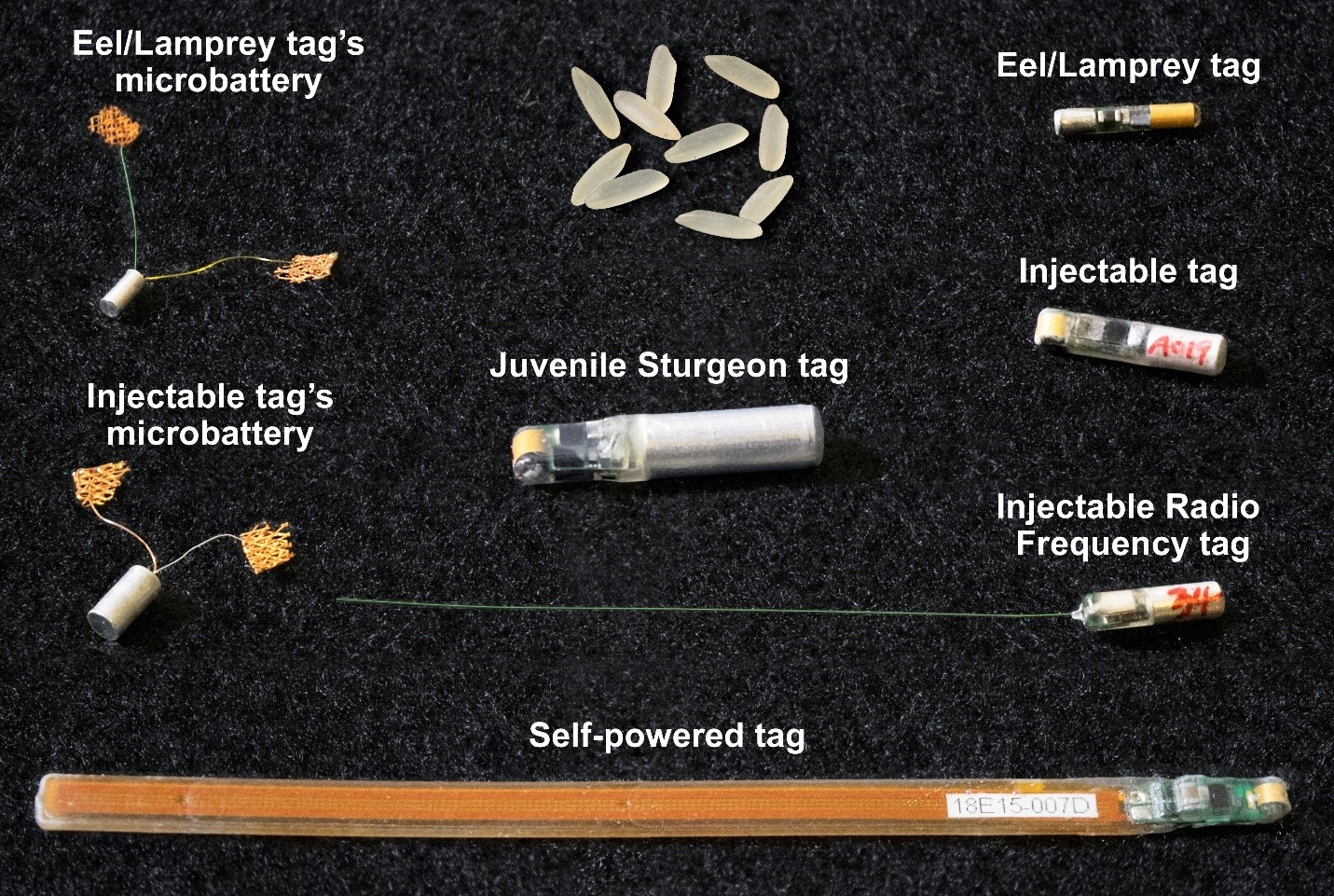
JSATS transmitters come in a variety of sizes, weights, and pulse rate intervals (PRIs) to accommodate a range of fish sizes, study durations, and study objectives. Each JSATS transmitter is encapsulated in an epoxy resin and outer Parylene coating and consists of a battery, a circuit board, and the transducer.
Once activated, the transmitter emits a uniquely coded 31 bit binary phase-shift keyed signal, which provides more than 65,000 individual tag codes. The signal is emitted at a frequency of 416.7 kHz and at a source level of approximately 156 dB (relative to 1 µPascal and 1 m). The length of time between signals is determined by the user-defined, pre-programmed PRI. Pulsing signals use less energy, which increases the life of the transmitter compared to continuous signals.
PNNL recently developed several new transmitters, including:
- an extended-life small acoustic transmitter that can be injected instead of surgically implanted,
- a long-life sturgeon tag,
- a self-powered acoustic transmitter,
- an eel/lamprey transmitter,
- lab-on-a-fish that integrates physiological and environmental sensors into acoustic transmitters,
- a low-frequency transmitter for marine animals, and
- an American shad transmitter.
JSATS transmitters have been produced by several commercial vendors, including Advanced Telemetry Systems, LOTEK Wireless, and Sonic Concepts, Inc.
Injectable Acoustic Transmitter
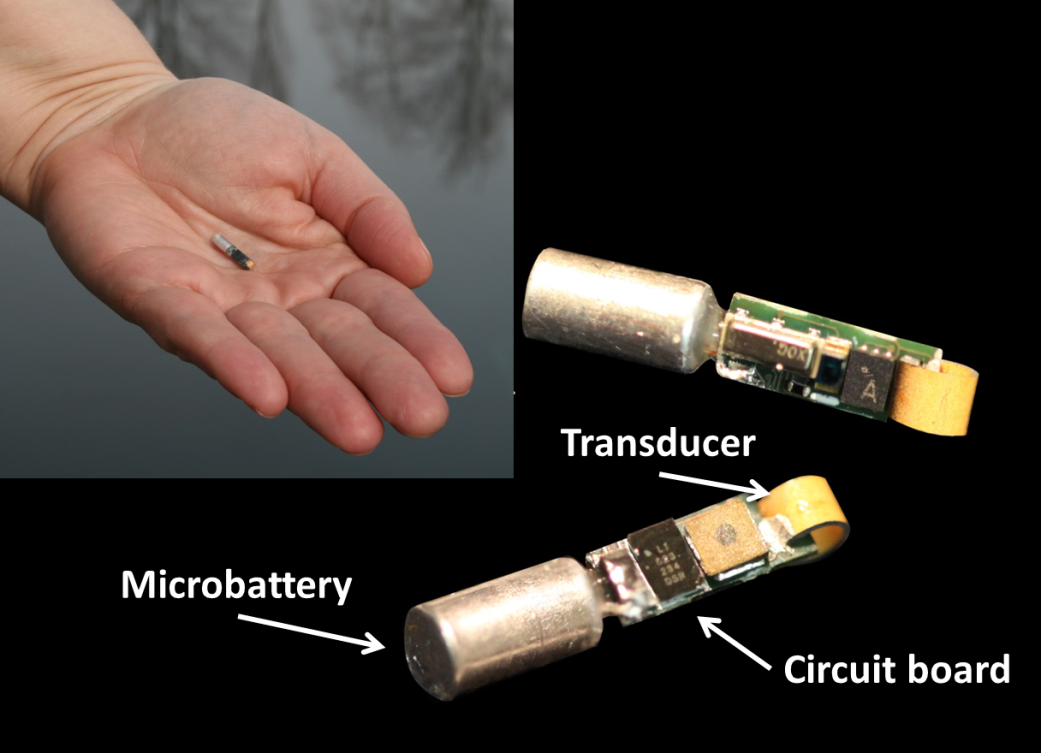
JSATS transmitters come in a variety of sizes, weights, and pulse rate intervals (PRIs) to accommodate a range of fish sizes, study durations, and study objectives. Each JSATS transmitter is encapsulated in an epoxy resin and outer Parylene coating and consists of a battery, a circuit board, and the transducer.
Once activated, the transmitter emits a uniquely coded 31 bit binary phase-shift keyed signal, which provides more than 65,000 individual tag codes. The signal is emitted at a frequency of 416.7 kHz and at a source level of approximately 156 dB (relative to 1 µPascal and 1 m). The length of time between signals is determined by the user-defined, pre-programmed PRI. Pulsing signals use less energy, which increases the life of the transmitter compared to continuous signals.
The patented injectable acoustic transmitter is available through Advanced Telemetry Systems. It can be injected into fish instead of surgically implanted. The injections take about 20 seconds compared to 2 to 3 minutes for surgical impanation and reduce the probability of adverse effects from implantation. The transmitter weighs 217 mg, is 15.00 mm long, and is 3.38 mm in diameter. The features include delayed start, the addition of a temperature sensor, and the ability to transmit two alternating codes. The injectable tag has a mean lifetime of greater than 120 days at a 3 second ping rate, compared to the lifetime of 23 days of existing technology at the same ping rate. Its performance has been verified in field studies.
PNNL also developed a patent-pending, low-frequency design, which is more suitable for marine applications. With ~200 kHz, it has a source level of 150 dB and a tag life of 140 days at a 5 second ping rate. Compared to the smallest commercially available low-frequency acoustic tag, our design is 16 dB higher in source level, significantly lighter in weight, and lasts three times longer.
More information about injectable transmitters can be found at:
An injectable acoustic transmitter for juvenile salmon
More information about the implantation can be found at:
Sturgeon Transmitter
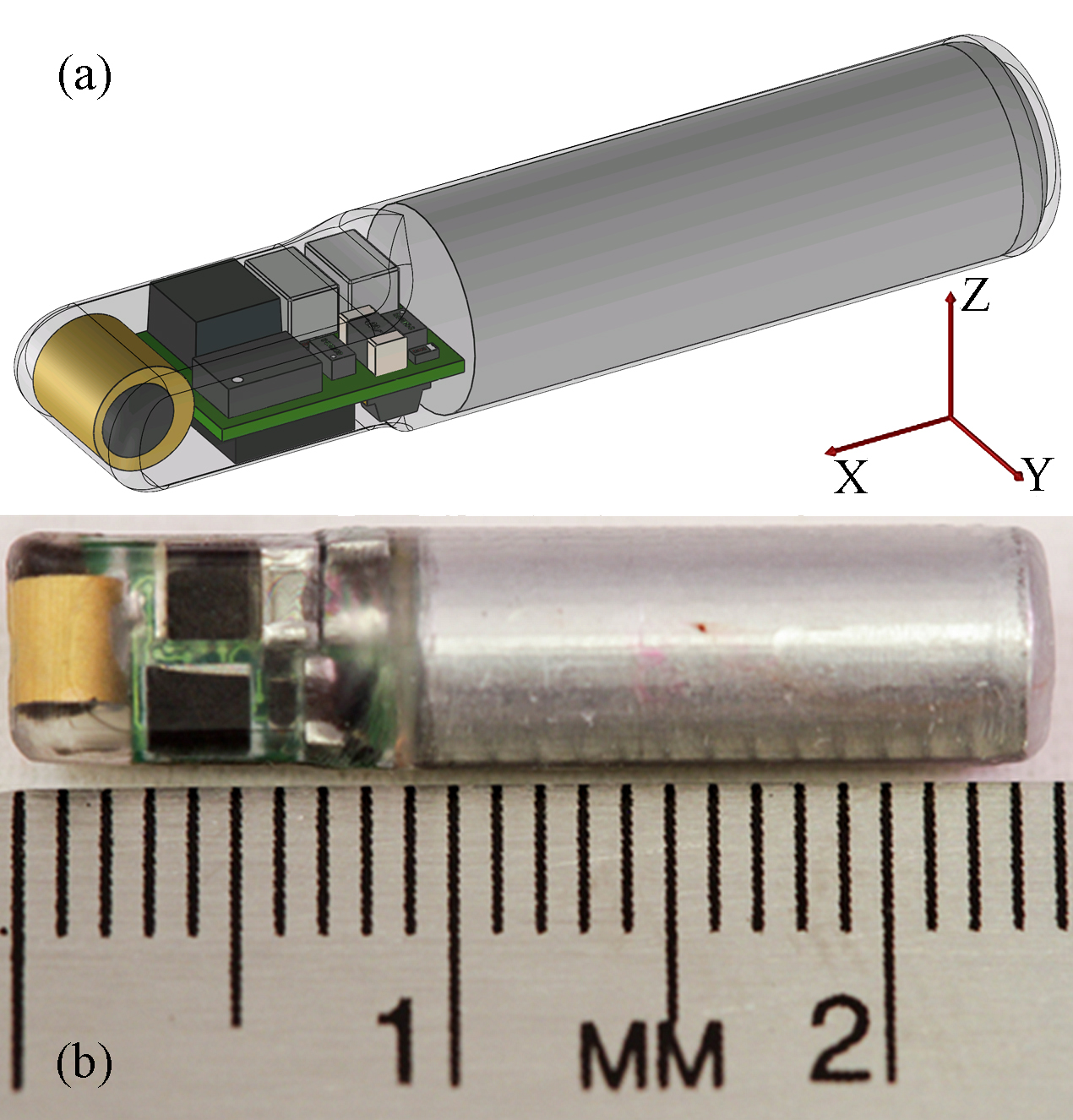
The sturgeon transmitter is a small long-life acoustic transmitter for studying the behavior of aquatic animals, such as sturgeon, adult lamprey, and adult eels. It has a length of 24.2 mm, diameter of 5.0 mm, and dry weight of 0.72 g. The transmitter generates a coded acoustic signal at 416.7 kHz with a selectable source level between 159 and 163 dB relative to 1 µPa at 1 m, allowing a detection range of up to 500 m in quiet environments. The expected operational lifetime is 1 year at a pulse rate interval of 15 seconds. Features include a configurable pulse rate interval and tag code, optional temperature measurement, alternating codes, and delayed start (hibernation mode). The new technology makes long-term acoustic telemetry studies of small fish possible.
Its applications include:
- Long-term tracking of small juvenile (< 1 year old) sturgeon
- Long-term monitoring of adult fish such as adult lamprey, salmon, and eel
- Noisy environment such as immediate tailrace due to higher source level
- Mobile tracking due to longer detection range
- Marine environment
More information about the transmitter can be found at:
A small long-life acoustic transmitter for studying the behavior of aquatic animals
Self-powered Transmitter
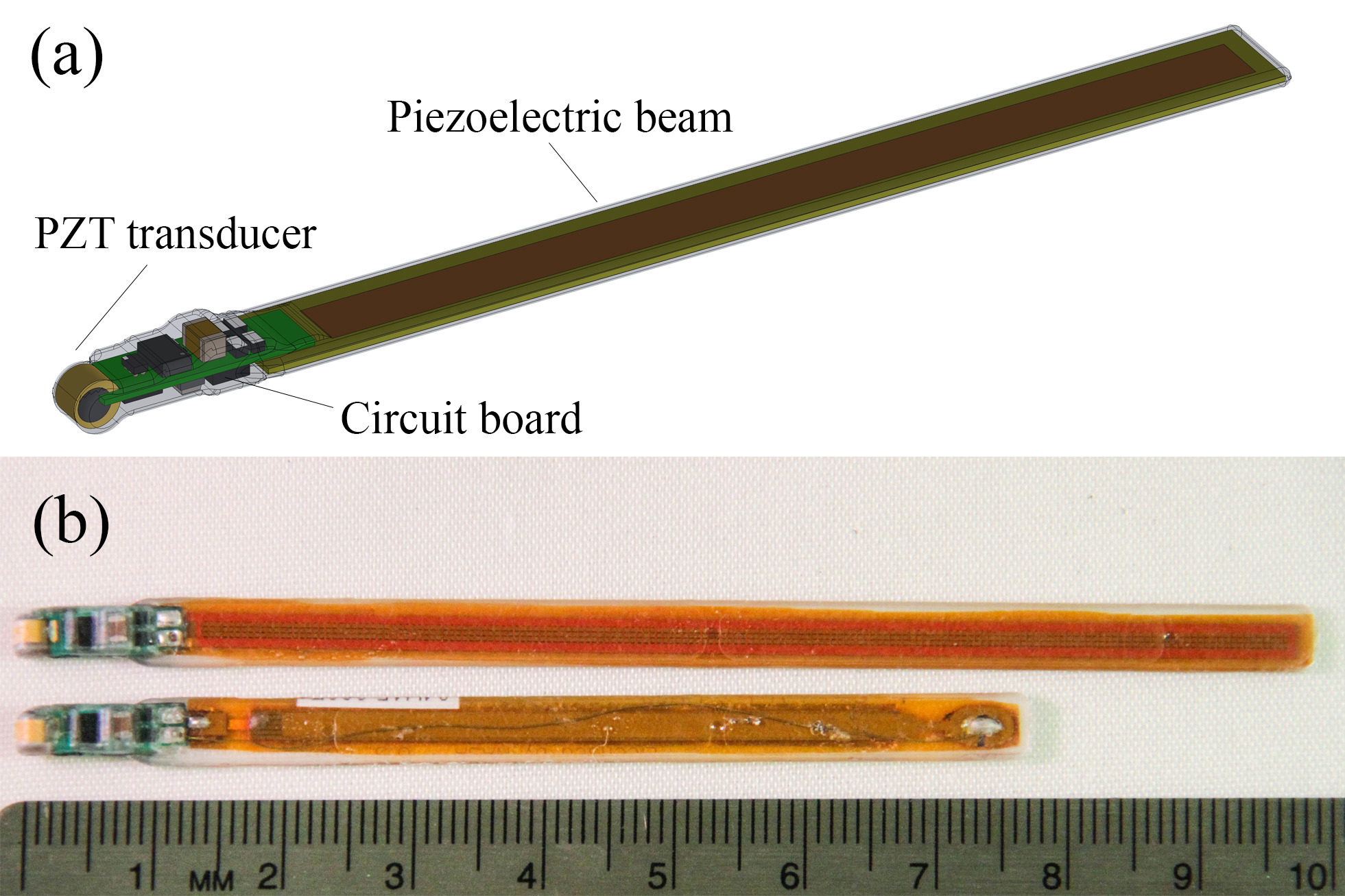
This transmitter uses the movement of the fish to power and recharge batteries, allowing data to be collected for well over a year instead of only a month or two. A longer monitoring period allows for a more complete view of fish behavior and of the impact of river obstructions on fish that have longer migration patterns, such as sturgeon, lamprey, and eel.
Two options of the transmitter designs were developed. Option 1 contains no battery and transmits signals as soon as sufficient energy for multiple transmissions is harvested. Option 2 transmits continuously at a set ping rate and has a rechargeable battery that stores the harvested energy. The tag is 5 mm wide and 1 mm thick for the majority of the tag body. Dependent upon the size and anatomy of the fish of interest, piezoelectric beams of various lengths can be used in this transmitter. In 2015, prototype transmitters of Option 1 at two different lengths were successfully evaluated in live fish. The longer one (100 mm long, 1.05 grams in air) was implanted in a 53-cm rainbow trout and the shorter one (77 mm long, 0.80 grams in air) was implanted in a 38-cm white sturgeon. Both transmitters were implanted subdermally on the back of the fish near the dorsal fin. The implantation process took about 75 seconds.
PNNL is interested in partnerships with operators or agencies interested in further developing and demonstrating this technology in both freshwater and marine environments.
More information about the transmitter can be found at:
An Energy Harvesting Underwater Acoustic Transmitter for Aquatic Animals
An implantable biomechanical energy harvester for animal monitoring devices
Eel/lamprey Transmitter
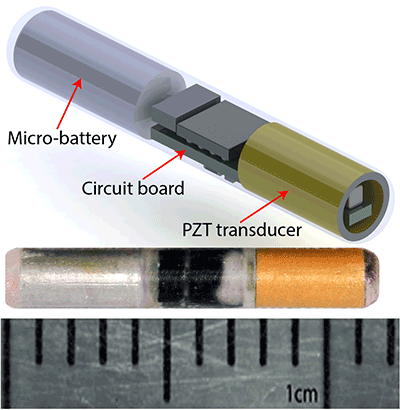
This acoustic transmitter was initially designed for studying juvenile eel and lamprey. It has been used to study American eel dam passage on the Potomac River in Maryland and the Roanoke River in North Carolina, as well as Pacific lamprey in the Columbia River Basin. A tagging study at PNNL also showed 100% survival for Chinook salmon with fork lengths of > 65 mm.
The transmitter weighs 0.08 g in air and 0.04 g in water, 12 mm long, and 2 mm in diameter. The transmitter prototype lasts approximately 40 days at a 5 second ping rate interval.
More information about the eel/lamprey transmitter can be found at:
Retention and Effects of Miniature Transmitters in Juvenile American Eels
Lab-on-a-Fish
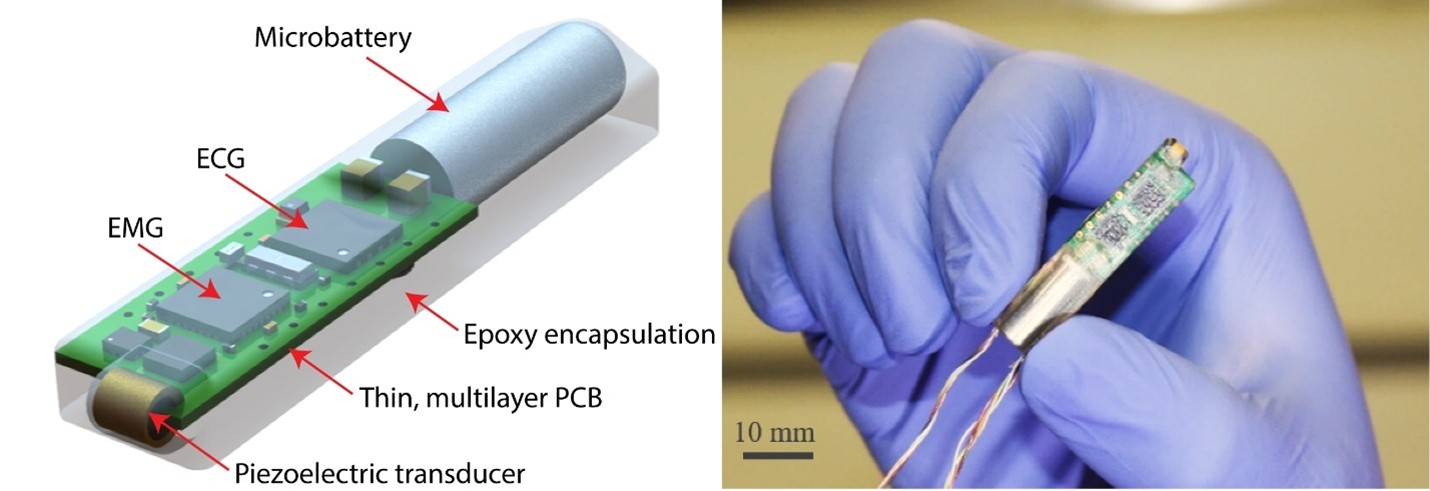
The patent-pending Lab-on-a-Fish simultaneously measures the two dominant physiological parameters of the fish as well as its behavior. Lab-on-a-Fish also evaluates environmental parameters such as temperature, pressure, and magnetic sensor with a weight of only 2.4 g and dimensions of 5.5 mm by 6.5 mm by 33 mm. The technology is capable of transmitting raw data in real time and storing it using on-board Flash memory. This is particularly helpful for acoustic communications or for complex post-data processing. Lab-on-a-Fish can provide the 3-D locations of a tagged animal, acting as an autonomous mobile sensor package that can associate sensor readings with specific locations.
PNNL is interested in partnerships with operators or agencies interested in further demonstrating this technology, especially for exploring applications to other key sensitive species in both freshwater and marine environments.
More information about Lab-on-a-Fish can be found at:
Low-frequency Transmitter for Marine Animals
The patented transmitter operates at 208.3 kHz and is designed for tracking aquatic animals in marine environments.
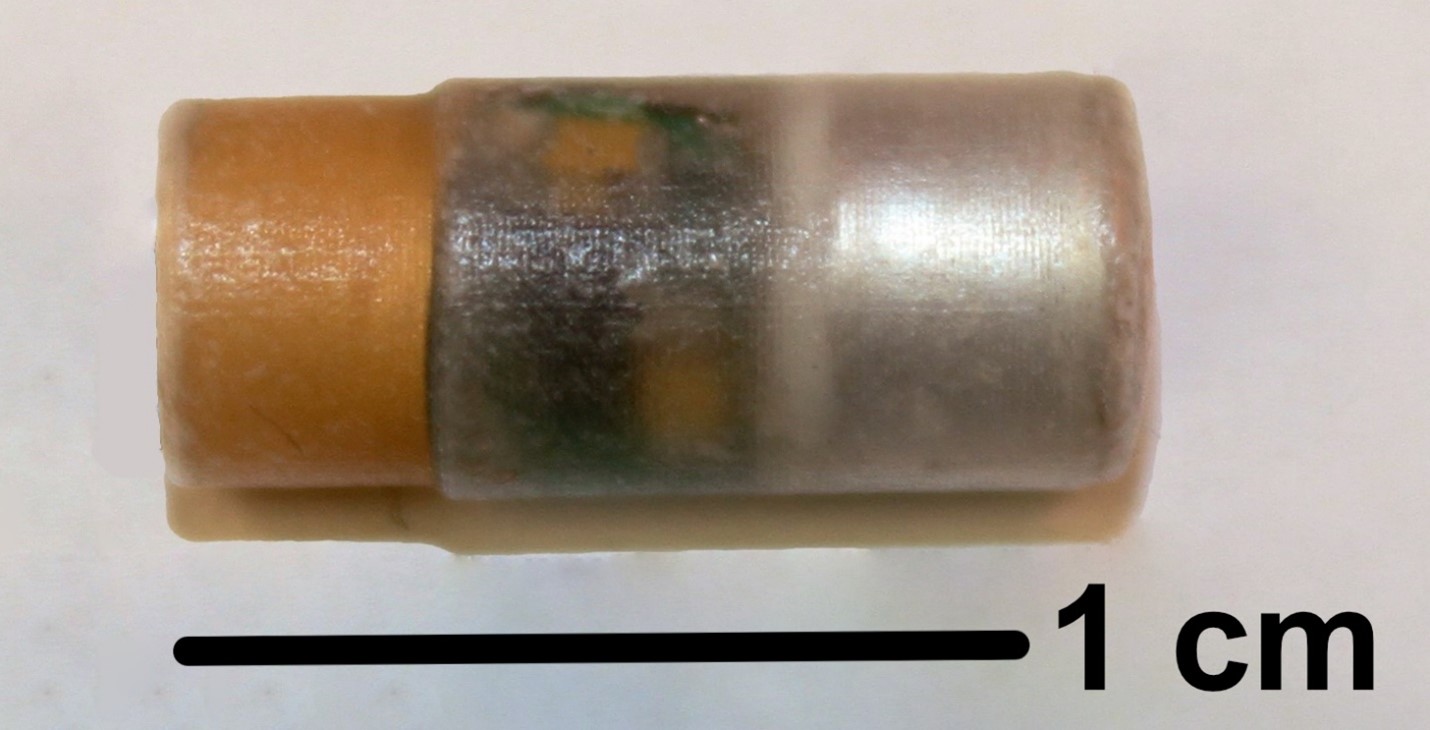
Compared to the commercial counterparts of similar sizes and weights, it offers significantly improved detection range and service life in a smaller, lighter package. In a relatively shallow marine environment, it had a detection range of 330 m. A unique feature is the programmable operation frequency, allowing manufacturers and users to readily adopt this new transmitter in their acoustic telemetry systems.
Specification highlights:
- Dry weight: 0.45 g
- Length: 11.8 mm
- Diameter: 5.1 mm
- Transmitter life: 140 days at 5-second ping rate
- Detection range in seawater: up to 330 m
American Shad Transmitter

PNNL’s smallest acoustic tag to date, this transmitter was designed specifically to track the movements of species and life stages of fish like American shad and Delta smelt that have never been studied before at high spatial and temporal scales. The transmitter weighs 0.05 g in air, is 7.6 mm long, and 2 mm in diameter. The transmitter prototype lasts approximately 30 days at a 5 second ping rate interval.
PNNL is interested in partnerships with operators or agencies interested in further demonstrating this technology in both freshwater and marine environments